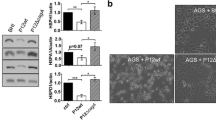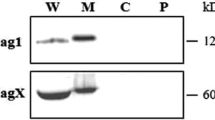Abstract
The human gastric pathogen Helicobacter pylori is extremely well adapted to the highly acidic conditions encountered in the stomach. The pronounced acid resistance of H. pylori relies mainly on the ammonia-producing enzyme urease. However, urease-independent mechanisms are likely to contribute to acid adaptation. pH-responsive gene regulation in this organism is mediated by a two-component system (HP0166-HP0165) designated ArsRS and the metal-dependent regulators NikR and Fur. Recently, it was reported that another two-component system termed CrdRS (HP1365-HP1364) is required for pH-responsive regulation of the major acid-resistance systems in the H. pylori strain J99. By the analysis of crdRS null mutants of the H. pylori strains 26695 and G27, we show that low pH induction of both the urease and the amidase genes occurs in the absence of crdRS in these strains, suggesting substantial strain-specific differences in the regulation of a major virulence determinant.





Similar content being viewed by others
Literature Cited
Beier D, Frank R (2000) Molecular characterization of two-component systems of Helicobacter pylori. J Bacteriol 182:2068–2076
Bijlsma JJE, Gerrits MM, Imamdi R, Vandenbroucke-Grauls CMJE, Kusters JG (1998) Urease-positive, acid-sensitive mutants of Helicobacter pylori: urease-independent acid resistance involved in growth at low pH. FEMS Microbiol Lett 167:309–313
Bijlsma JJE, Waidner B, van Vliet AHM, Hughes NJ, Häg S, Bereswill S, Kelly DJ, Vandenbroucke-Grauls CMJE, Kist M, Kusters JG (2002) The Helicobacter pylori homologue of the ferric uptake regulator is involved in acid resistance. Infect Immun 70:606–611
Bury-Moné S, Skouloubris S, Dauga C, Thiberge J-M, Dailidiene D, Berg DE, Labigne A, De Reuse H (2003). Presence of active aliphatic amidases in Helicobacter species able to colonize the stomach. Infect Immun 71:5613–5622
Bury-Moné S, Thiberge J-M, Contreras M, Maitournam A, Labigne A, De Reuse H (2004) Responsiveness to acidity via metal ion regulators mediates virulence in the gastric pathogen Helicobacter pylori. Mol Microbiol 53:623–638
Eaton KA, Krakowka S (1994) Effect of gastric pH on urease-dependent colonization of gnotobiotic piglets by Helicobacter pylori. Infect Immun 62:3604–3607
Ferrero RL, Cussac V, Courcoux P, Labigne A (1992) Construction of isogenic urease-negative mutants of Helicobacter pylori by allelic exchange. J Bacteriol 174:4212–4217
Gancz H, Censini S, Merrell DS (2006) Iron and pH homeostasis intersect at the level of Fur regulation in the gastric pathogen Helicobacter pylori. Infect Immun 74:602–614
Labigne-Roussel A, Courcoux P, Tompkins L (1988) Gene disruption and replacement as feasible approach for mutagenesis of Campylobacter jejuni. J Bacteriol 170:1704–1708
Loh JT, Cover TL (2006) Requirement of histidine kinases HP0165 and HP1364 for acid resistance in Helicobacter pylori. Infect Immun 74:3052–3059
Merrell DS, Goodrich ML, Otto G, Tompkins LS, Falkow S (2003) pH-regulated gene expression of the gastric pathogen Helicobacter pylori. Infect Immun 71:3529–3539
Pflock M, Dietz P, Schär J, Beier D (2004) Genetic evidence for histidine kinase HP165 being an acid sensor of Helicobacter pylori. FEMS Microbiol Lett 234:51–61
Pflock M, Kennard S, Delany I, Scarlato V, Beier D (2005) Acid-induced activation of the urease promoters is mediated directly by the ArsRS two-component system of Helicobacter pylori. Infect Immun 73:6437–6445
Pflock M, Finsterer N, Joseph B, Mollenkopf H, Meyer TF, Beier D (2006) Characterization of the ArsRS regulon of Helicobacter pylori, involved in acid adaptation. J Bacteriol 188:3449–3462
Tomb J-F, White O, Kerlavage AR, Clayton R, Sutton GG, Fleischmann RD, Ketchum KA, Klenk HP, Gill S, Dougherty BA, Nelson K, Quackenbush J, Zhou L, Kirkness EF, Peterson S, Loftus B, Richardson D, Dodson R, Khalak HG, Glodek A, McKenney K, Fitzegerald LM, Lee N, Adams MD, Hickey EK, Berg DE, Gocayne JD, Utterback TR, Peterson JD, Kelley JM, Cottonn MD, Weidman JM, Fujii C, Bowman C, Watthey L, Wallin E, Hayes WS, Borodovsky M, Karp PD, Smith HO, Fraser CM, Venter JC (1997) The complete genome sequence of the gastric pathogen Helicobacter pylori. Nature 388:539–547
Tsuda M, Karita M, Morshed MG, Okita K, Nakazawa T (1994) A urease-negative mutant of Helicobacter pylori constructed by allelic exchange mutagenesis lacks the ability to colonize the nude mouse stomach. Infect Immun 62:3586–3589
van Vliet AHM, Kuipers EJ, Stoof J, Poppelaars SW, Kusters JG (2004) Acid-responsive gene induction of ammonia-producing enzymes in Helicobacter pylori is mediated via a metal-responsive repressor cascade. Infect Immun 72:766–773
Waidner B, Melchers K, Stähler FN, Kist M, Bereswill S (2005) The Helicobacter pylori CrdRS two-component regulation system (HP1364/HP1365) is required for copper-mediated induction of the copper resistance determinant CrdA. J Bacteriol 187:4683–4688
Wen Y, Marcus EA, Matrubutham U, Gleeson MA, Scott DR, Sachs G (2003) Acid-adaptive genes of Helicobacter pylori. Infect Immun 71:5921–5939
Wen Y, Feng J, Scott DR, Marcus EA, Sachs G (2006) Involvement of the HP0165-HP0166 two-component system in expression of some acidic-pH-upregulated genes of Helicobacter pylori. J Bacteriol 188:1750–1761
Xiang Z, Censini S, Bayeli PF, Telford JL, Figura N, Rappuoli R, Covacci A (1995) Analysis of expression of CagA and VacA virulence factors in 43 strains of Helicobacter pylori reveals that clinical isolates can be divided into two major types and that CagA is not necessary for expression of the vacuolating cytotoxin. Infect Immun 63:94–98
Acknowledgments
This work was supported by a grant from the Deutsche Forschungsgemeinschaft (BE 1543/6-1).
Author information
Authors and Affiliations
Corresponding author
Rights and permissions
About this article
Cite this article
Pflock, M., Müller, S. & Beier, D. The CrdRS (HP1365-HP1364) Two-Component System Is Not Involved in pH-Responsive Gene Regulation in the Helicobacter pylori Strains 26695 and G27. Curr Microbiol 54, 320–324 (2007). https://doi.org/10.1007/s00284-006-0520-9
Received:
Accepted:
Published:
Issue Date:
DOI: https://doi.org/10.1007/s00284-006-0520-9




